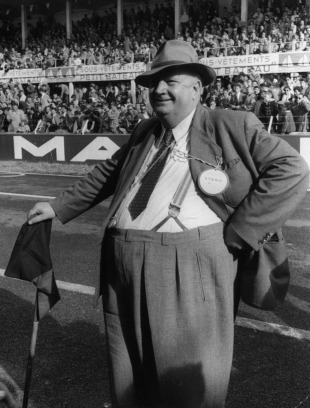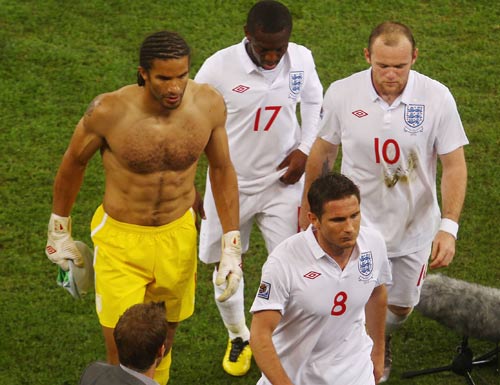
- Drivers:
- Lord Hesketh
- |
- Flavio Briatore
- |
- Colin Chapman
- |
- Ron Dennis
- |
- Bernie Ecclestone
- |
- Enzo Ferrari
- |
- Raymond Mays
- |
- Alfred Neubauer
- |
- Jean Todt
Alfred Neubauer
The original team boss, Neubauer quite literally invented the position of team principal. After serving in the First World War he fulfilled his dream of becoming a test and race driver for Austro-Daimler, working under the legendary Ferdinand Porsche. It soon became clear that his driving talents were limited and at that point he appointed himself as the Rennleiter [racing team manager]. It proved to be an inspired career choice as Mercedes, which merged with Dailmler in 1926, went on to become the powerhouse of grand prix racing in the 1930s and again in the 1950s under his orders. He was instantly recognisable in the pits with his spherical gut and trilby hat, but respected by one and all. He treated his drivers in a firm but controlled manner and created a system of boards and flags to communicate with them out on track. He came up with almost every trick in the book and brought a level of professionalism to the sport that changed the face of motor racing forever.
Enzo Ferrari
The most evocative name on the list, Ferrari founded the most successful Formula One team ever. Often compared to a mafia-style Don, il Commendatore - as he was known - had a cold and ruthless managing style that built up an almost mystical aura about him. His love was usually reserved for his cars over his drivers and the emphasis was always on the engine first and the chassis later. However, he rewarded bravery in his drivers and certain names, such as Gilles Villeneuve, earned a special place in his heart. Despite selling a large part of his company to FIAT in the 1960s he remained involved in his team right up until his death in 1988 and lived in a house within the grounds of the factory and the team's test track.
Flavio Briatore
One of the most controversial characters to step foot in the F1 paddock, Briatore personifies the very best and worst elements of the sport. Unlike the others on this list he had no burning desire to be a part of F1 before he was appointed a team manager, but precisely because of that he was never too emotionally involved and proved to be a highly analytical and successful manager at Benetton, which later became Renault. Despite overseeing four titles and providing a launch pad for two of the best drivers of the past 20 years [Michael Schumacher and Fernando Alonso], he will always be remembered for his part in the Crashgate scandal, for which he was initially slapped with a life-time ban by the FIA. But Briatore is no stranger to controversy - prior to his involvement in F1 he was convicted of fraud and fled to the Virgin Islands - and could well return to the sport after his ban lapses in 2013.
Bernie Ecclestone
His career started from humble beginnings by selling motorbike parts between shifts at his local gasworks. But it wasn't long before Ecclestone's entrepreneurial spirit started to reap serious financial rewards and he used the proceeds of his burgeoning motorbike and carsales business to buy a couple of Connaught F1 cars. His real success, however, came in the 1970s when he bought Brabham and took it to two drivers' titles with Nelson Piquet in the 1980s. He paid $120,000 for the team but sold it off in 1987 for over $5 million. During that time he increased his presence in the sport through the Formula One Constructors' Association and was instrumental in organising and selling TV rights, a venture that put him in the position he holds in today.
Ron Dennis
Dennis is a complete and utter perfectionist, to the point that he has often been considered a control freak. However, it is his obsessive nature that has made McLaren the second most successful team in F1 history, and still a championship contender today. In an environment where tenths of a seconds can be the difference between winning and losing, Dennis' attention to detail and extremely high expectations of his employees has seen McLaren win 7 constructors' championships and 10 drivers' titles under his management.

Possibly the most innovative team boss on the list, Chapman and Team Lotus were constantly pushing the rules to the absolute limit to find an advantage. On occasions, such as when Lotus perfected the use of ground effect aerodynamics on the Type 79, the results were dramatic and his genius made teams such as Ferrari look backwards. He was a real trendsetter but at times pushed the limits with his cars and breakages were often a concern for his drivers. Nevertheless, his approach netted Lotus seven constructors' championships while he was team boss.
Jean Todt
The ultimate man manager, Todt is a true delegator who brought together one of the most formidable teams ever seen in F1. He made his name with Peugeot in rallying and sports car racing, but the French firm's reluctance to enter Formula One saw him snapped up by Ferrari's new president Luca di Montezemolo in 1993 to put an end to the team's longstanding losing streak. In 1996 Todt secured the services of two-time champion Michael Schumacher from Benetton, who was followed by Ross Brawn (strategist) and Rory Byrne (designer). As the team gelled around this core it became an unstoppable force, with Schumacher winning five titles in a row between 2000 and 2004. However, Todt's commitment to Ferrari could be to the detriment of the sport, and when he ordered Rubens Barrichello to concede victory at the 2002 Austrian Grand Prix to Michael Schumacher many thought he had gone too far. The hope now is that he will bring all the positive aspects of his leadership to his role as FIA president.
Lord Hesketh
A true eccentric, who, rather ironically given his own family lineage and place in society, took on the F1 establishment and won. The third Baron Hesketh used his family fortune to go racing and set up a Formula 3 team in 1972 with the main objective of having as much fun as possible. Within a year he stumbled across a promising young English driver called James Hunt, who was fast but known for crashing. At the start of 1973 Hesketh bought Hunt an F2 car that was almost immediately written off at the Pau Grand Prix. Assuming that, at this rate, the cost of competing in F1 wasn't going to be hugely more expensive, Hesketh decided to join the top flight. The fervently patriotic team continued with its mantra of fun, holding parties at which Hunt soon cemented his reputation as the sport's ultimate playboy. Baulking at the convention of sponsorship, Hesketh poured more and more money into the project, recruiting the services of Harvey Postlethwaite to design the 1974 car. Soon enough the team started challenging for podium positions and in 1975 took victory at the Dutch Grand Prix, beating the Ferrari of Niki Lauda. Hesketh had rocked the F1 world, but by this time Hunt had outgrown the team and landed a contract with McLaren for 1976. Just three years after it had begun, the dream was over for Hesketh and running low on funds, he decided to call it a day. The team raced on with sponsorship until 1978 but never reached the heights of 1975 again.
Sir Frank Williams
The longest serving boss in the paddock, Williams has taken his team from absolutely nothing to world champions and occupied every position on the grid in between. He first entered an F1 car in 1969 and after a relative lack of success with Frank Williams Racing Cars and Walter Wolf racing, in 1977 he set up the Williams F1 team we know today. By 1980 he had won the championship but his glory days were in the 1990s when his team won five constructors' titles and dominated the sport in 1992, 1993, 1996 and 1997.
Raymond Mays
He raced cars for three decades but it was in a managerial role at the pre-war English Racing Automobiles (ERA) and post-war British Racing Motors (BRM) that he really made his mark. In an era of continental domination, Mays was desperate for British success but all too often suffered from a lack of funding. Before the war he spearheaded ERA, whose cars were first raced as a works team and then sold to customers to race on as privateers. The BRM project, started in 1945, became a national preoccupation but sadly it lurched from crisis to crisis. In 1950 the car finally appeared at the British Grand Prix - albeit briefly as its ludicrously complicated V16 engine self destructed. All summer the hype around the BRM grew, but on the its second outing in August it managed to move a foot before stopping. An angry crowd pelted it with coins. Despite a few appearances in 1951, Mays was replaced the following year. He was a colourful character. The press at the time often referred to him being "immaculately dressed" and "elegant". The reality was he liked to wear eye-liner while driving, and it was widely rumoured Peter Berthon was more than just his business partner.
Laurence Edmondson is an assistant editor on ESPNF1
© ESPN Sports Media Ltd.
 Laurence Edmondson is deputy editor of ESPNF1 Laurence Edmondson grew up on a Sunday afternoon diet of Ayrton Senna and Nigel Mansell and first stepped in the paddock as a Bridgestone competition finalist in 2005. He worked for ITV-F1 after graduating from university and has been ESPNF1's deputy editor since 2010
Laurence Edmondson is deputy editor of ESPNF1 Laurence Edmondson grew up on a Sunday afternoon diet of Ayrton Senna and Nigel Mansell and first stepped in the paddock as a Bridgestone competition finalist in 2005. He worked for ITV-F1 after graduating from university and has been ESPNF1's deputy editor since 2010

